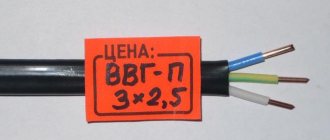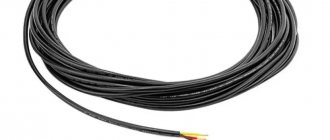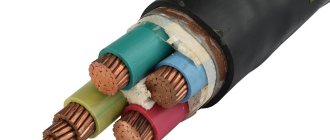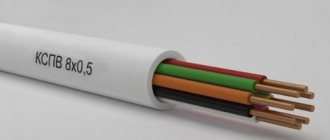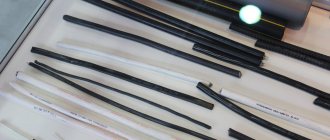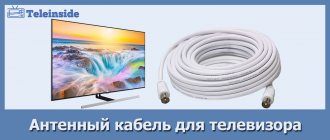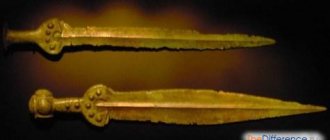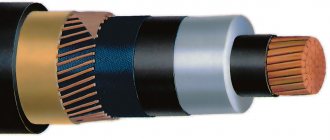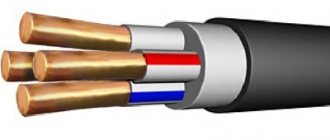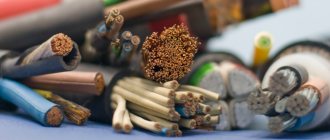To lay an underground electrical route, a conductor is required that has sufficient protection from possible atmospheric, compression and mechanical influences that will affect it during the entire period of operation. Such cable and wire products must have reliable insulation, tight sealing and good armor coating. All these qualities are endowed with the ASB power cable, created specifically for operation in such conditions. In this article we will talk about the ASB cable, consider its design, characteristics and areas of application.
Decoding
The order of decoding the abbreviation ASB 3x150:
- A – aluminum is used as a material for conductive conductors,
- C – the conductors are made in a lead sheath,
- B – the cable is additionally protected with steel tapes,
- 3 – number of cores,
- 120 – core cross-section, mm².
ASB 3x120
The core insulation is made in different colors, digital marking is also possible.
The most common mistakes when using ASB cable
- Unwinding a cable from a drum lying on its side. Such unwinding is unacceptable according to all current standards. The fact is that when the product is thrown off with rings, it twists, and when trying to align, longitudinal tension may occur, which is strictly prohibited for a cable.
- When laying open, to overcome obstacles, the product is suspended in the air at a short distance. This is also a gross violation of technology, because the significant weight of the product will certainly lead to its sagging, which means stretching, and when using ASB, this is unacceptable.
- Exceeding the load on the cable (the core cross-section has a smaller area than required) through the connection of additional consumers. Such a violation can lead to significant heating of the phase conductors, as a result of which the properties of the insulating material will be impaired and further operation of the product will become unsafe.
In conclusion, I would like to note that work on unwinding, installation and switching of power cables should be carried out by specialists who have the appropriate education, skills and permission to carry out these activities. Compliance with operating rules will help extend the service life of the cable, which has a significant service life and is designed for more than 30 years.
- Technical characteristics of PPV wire
- Wire PV-3: technical characteristics, scope, manufacturers
- Recommendations for the selection and use of VVG power cable
- Device for unwinding cable in coils
- Rating of the best Russian and foreign cable manufacturers
Design
The cable design requires the following elements:
- aluminum conductors of round or sector cross-section, made in the form of solid wire or multi-wire;
- an insulating coating consisting of paper impregnated with a special composition;
- pillows for which bitumen, crepe paper or polyethylene terephthalate fibers are used;
- armored protection made of steel tapes;
- outer cover made of bitumen or glass yarn.
Depending on the type, an additional coating layer of bitumen tape may be used.
Technical and operational characteristics of ASB
Before putting into operation, each product is tested in specialized laboratories. The cable is tested by applying a voltage to it that is twice or more its rated value:
- for products designed for 1 kV – test voltage – 4 kV;
- at 6 kV – 17 kV;
- at 10 kV – 25 kV.
The main parameters characterizing cable and wire products are the following:
- rated voltage – 1,6,10 kV;
- current frequency – 50 Hz;
- long-term permissible temperature for products at 1 and 6 kV - +80°C,
- at 10 kV - +70°C;
- products with single-wire conductors – 15 D external,
It is more convenient to present other parameters of the most commonly used products in the form of a table:
| Number of cores and their cross-sectional area, mm² | R max at t +20°С, Ohm/km | Lead sheath, mm | External cable D, mm | Standard length supplied, m | Product weight, kg/km |
| 1000 V cables | |||||
| 3x35.0 | 0,87 | 1,11 | 30,10 | 450 | 1947 |
| 3x50.0 | 0,64 | 1,15 | 31,70 | // | 2157 |
| 3х70ozh | 0,44 | 1,21 | 34,50 | // | 2532 |
| 3х95ozh | 0,32 | 1,26 | 37,70 | 400 | 3077 |
| 3х120ozh | 0,25 | 1,32 | 40,60 | // | 3623 |
| 3x150.0 | 0,21 | 1,36 | 45,40 | 350 | 4458 |
| 3x185.0 | 0,16 | 1,42 | 48,70 | // | 5109 |
| 3x240.0 | 0,13 | 1,52 | 55,30 | // | 6548 |
| 3x50+1x25 | 0,64/1,2 | 1,21 | 34,40 | 450 | 2593 |
| 3x70+1x35 | 0,44/0,87 | 1,26 | 38,90 | // | 3375 |
| 3x95+1x50 | 0,32/0,64 | 1,32 | 42,70 | 400 | 4020 |
| 3x120+1x70 coolant | 0,25/0,44 | 1,45 | 46,0 | // | 4517 |
| 3x150+1x70 coolant | 0,21/0/44 | 1,45 | 49,70 | 350 | 5252 |
| 4x35.0 | 0,87 | 1,15 | 33,40 | 450 | 2353 |
| 4x50.0 | 0,64 | 1,21 | 36,20 | // | 2687 |
| 4x70.0 | 0,44 | 1,26 | 41,10 | // | 3674 |
| 4х95ozh | 0,32 | 1,36 | 41,90 | 400 | 3857 |
| 4x120.0 | 0,25 | 1,42 | 47,70 | // | 4831 |
| 4x150.0 | 0,21 | 1,46 | 48,80 | 350 | 5480 |
| 4x185.0 | 0,16 | 1,56 | 51,50 | // | 6208 |
| 6000 V cables | |||||
| 3x50.0 | 0,64 | 1,32 | 37,70 | 450 | 2928 |
| 3x70.0 | 0,44 | 1,42 | 42,40 | // | 3840 |
| 3х95ozh | 0,32 | 1,36 | 43,70 | 400 | 4014 |
| 3х120ozh | 0,25 | 1,42 | 45,90 | // | 4490 |
| 3x150.0 | 0,21 | 1,46 | 50,60 | 350 | 5400 |
| 3x185.0 | 0,16 | 1,52 | 53,40 | // | 6029 |
| 3x240.0 | 0,13 | 1,62 | 59,90 | // | 7560 |
| Cables 10000 V | |||||
| 3х95ozh | 0,32 | 1,46 | 47,60 | 400 | 4708 |
| 3х120ozh | 0,25 | 1,52 | 49,90 | // | 5219 |
| 3x150ozh | 0,21 | 1,56 | 52,80 | 350 | 5853 |
| 3х185ozh | 0,16 | 1,62 | 55,40 | // | 6536 |
| 3x240ozh | 0,13 | 1,68 | 60,10 | // | 7742 |
The cross-sectional shape of current-carrying conductors can be round or sector. This applies to single- and multi-wire conductors.
Storage and transportation requirements
Transportation and storage of ASB power cable is carried out on wooden drums.
The product is released from the enterprise on wooden and metal drums No. 14-No. 22 with a neck diameter of 750-1320 mm and a length of 710-1000 mm. It is recommended to carry out transportation and storage on the same drums, and they should only be in a vertical position. Under no circumstances is it permissible to transport the drum with the cable lying on its “cheek”.
Cable Installation Requirements
One of the conditions for using ASB cable products is the absence of stray currents in the soil. This is especially important when installing products at 6 and 10 kV, when the presence of stray currents must be completely excluded for safety reasons. Particular attention should be paid to the impregnating composition used in the conductor. Laying an impregnated ASB cable from non-draining joints is allowed on almost any route slope. The use of fluid impregnation compounds imposes restrictions on the operation of the product:
- the difference in levels should not exceed 25 m;
- If the height difference is more than 15 meters, the use of locking couplings becomes a prerequisite.
The depth of the cable in the ground must be at least 0.85 m. The bottom of the trench is covered with a sand cushion, on which the conductor is laid, and a layer of sand of approximately 20 cm is again poured on top. To mark the cable route and protect it from mechanical damage, a signal protective tape is laid along the entire length. After this, the trench is filled with soil.
Practical recommendation: When an electric line passes under a roadway, the cable is placed in a metal pipe and in a cable channel, which provides additional protection.
When laid under the roadway, the conductor is placed in a cable channel and pipe
. The minimum ambient temperature at which installation is allowed is not lower than 0°C, although after installation, in a stationary state, the cable remains operational at -50°C.
Purpose and application
The ASB cable, given its properties, is mainly used for transmitting electricity in stationary electrical equipment with an operating voltage ranging from 1.6 to 10 kV. It can also be used to transmit direct current.
In most cases, this type of power cable is used for underground communications. Laying is carried out under conditions of low or medium corrosive activity of the soil and the absence of stray currents in the area where the wire is located. For operation in aggressive environments, a type of product with additional protection is used, the marking of which contains the additional designation 2l.
Installation features
It is worth considering that all the technical parameters given will work at full strength only subject to high-quality installation and compliance with the necessary operating conditions.
For example, when laying and using power cables, it is recommended to pay attention to the following norms and standards:
- Installation of a cord of this type is carried out only at positive temperatures, since “minus” will cause damage to the insulating layer, the appearance of microcracks, breaks, which can lead to current leakage.
- Corrosive activity levels no higher than average are considered optimal for underground installation of standard types of power conductor.
- Highly corrosive soil requires the use of insulation-reinforced ASB2l grades.
- Stretching the wire is unacceptable, as the structure may become unusable.
- When installing underground lines, you must make sure that there are no stray currents in the soil.
Classification and price
In addition to the main variety, ASBl and ASB2l cables are produced, which provide additional protection for use in aggressive environments.
Also read: How to Test Transformer Insulation
The cable differs in the following design features:
- number of cores – from 1 to 4;
- cross-sectional area, ranging from 35 to 240 sq. mm.
Depending on the specified features, the cost of a linear meter of this product ranges from 500 to 900 rubles and more. Also, the price depends on the policy of the company selling the products.
Advantages and disadvantages of wire
ASB has the following advantages:
- reliable protection from mechanical influences, thanks to armor;
- cheaper manufacturing cost compared to copper products;
- high conductivity;
- possibility of underground installation;
- wide choice, depending on operating conditions.
The disadvantages include large weight and insufficient flexibility, and therefore the wire is not suitable for use in overhead routes.
